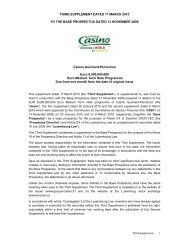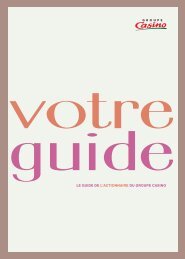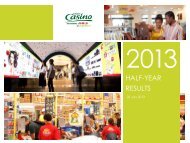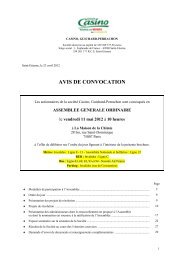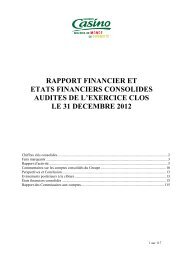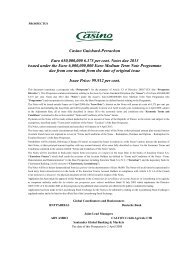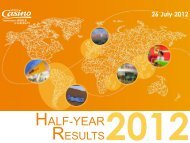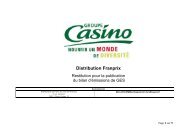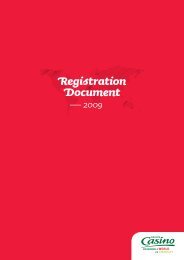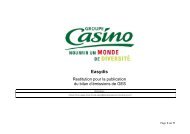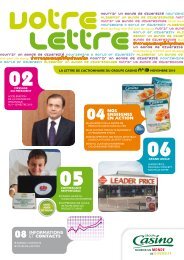2010 REGISTRATION DOCUMENT (3.4 Mo) - Groupe Casino
2010 REGISTRATION DOCUMENT (3.4 Mo) - Groupe Casino
2010 REGISTRATION DOCUMENT (3.4 Mo) - Groupe Casino
Create successful ePaper yourself
Turn your PDF publications into a flip-book with our unique Google optimized e-Paper software.
CONSOLIDATED FINANCIAL STATEMENTSNotes to the consolidated fi nancial statements3■cash flow hedges (for example, swaps to convert floating rate debtto fixed rate). For these hedges, the effective portion of the change inthe fair value of the derivative is recognised in equity and reclassifiedinto the income statement on a symmetrical basis with the hedgedcash flows and under the same line item as the hedged item (i.e.trading profit for hedges of operating cash flows and net financialincome or expense for other hedges). The ineffective portion isrecognised directly in the income statement.Hedge accounting may only be used if:■■the hedging relationship is clearly defined and documented atinception; andthe effectiveness of the hedge can be demonstrated at inceptionand throughout its life.Note 1.5.14.3.2. Derivative financial instruments thatdo not qualify for hedge accounting:recognition and presentationWhen a derivative financial instrument does not qualify or no longerqualifies for hedge accounting, changes in fair value are recogniseddirectly in profit or loss for the period under “Other financial incomeand expense”.Note 1.5.15. Fair value of f inancial instrumentsFair value measurements are classified using a fair value hierarchythat reflects the significance of the inputs used in making themeasurements. The fair value hierarchy has the following levels:■■■quoted prices (unadjusted) in active markets for identical assetsor liabilities (Level 1);inputs other than quoted prices included within Level 1 that areobservable either directly (i.e. as prices) or indirectly (i.e. derivedfrom prices) (Level 2);inputs for the asset or liability that are not based on observablemarket data (unobservable inputs) (Level 3).The fair value of financial instruments traded in an active market isthe quoted price on the balance sheet date. A market is consideredas active if quoted prices are readily and regularly available from anexchange, dealer, broker, industry group, pricing service or regulatoryagency, and those prices represent actual and regularly occurringmarket transactions on an arm’s length basis. These instrumentsare classified as Level 1.The fair value of financial instruments which are not quoted in an activemarket (such as over-the-counter derivatives) is determined usingvaluation techniques. These techniques use observable market datawherever possible and make little use of the Group’s own estimates.If all the inputs required to calculate fair value are observable, theinstrument is classified as Level 2.If one or more significant inputs are not based on observable marketdata, the instrument is classified as Level 3.Note 1.5.16. InventoriesInventories are measured at the lower of cost and net realisable value,determined by the first-in first-out (FIFO) method.The cost of inventories comprises all costs of purchase, costs ofconversion and other costs incurred in bringing inventories to theirpresent location and condition. Accordingly, logistics costs are includedin the carrying amount and supplier discounts recognised in “Cost ofgoods sold” are deducted.The cost of inventory includes gains or losses on cash flow hedgesof future inventory purchases initially recognised in equity.Net realisable value is the estimated selling price in the ordinary courseof business less the estimated costs of completion and the estimatedcosts necessary to make the sale.Property development work in progress is recognised in inventories.Note 1.5.17. Non-current assets held for saleand discontinued operationsNon-current assets classified as held for sale are measured at thelower of their carrying amount and their fair value less costs to sell.A non-current asset (or disposal group) is classified as held for sale ifits carrying amount is recovered principally through a sale transactionrather than through continuing use. For this condition to be met, theasset (or disposal group) must be available for immediate sale in itspresent condition and its sale must be highly probable. For the saleto be highly probable, management must be committed to a plan tosell the asset (or disposal group), and the sale should be expectedto qualify for recognition as a completed sale within one year fromthe date of classification.In the consolidated income statement for the current and prior periods,the post-tax results of discontinued operations and any gain or loss onsale are presented as a single amount on a separate line item belowthe results of continuing operations, even where the Group retains aminority interest in the subsidiary after its sale.Property, plant and equipment and intangible assets classified as heldfor sale are no longer depreciated or amortised.Note 1.5.18. EquityNote 1.5.18.1. Equity instruments and hybridinstrumentsThe classification of instruments issued by the Group in equity or debtdepends on each instrument’s specific characteristics. An instrument isdeemed to be an equity instrument when the following two conditionsare met: (i) the instrument does not contain a contractual obligationto deliver cash or another financial asset to another entity, or toexchange financial assets or financial liabilities with another entityunder conditions that are potentially unfavourable to the entity; and (ii)in the case of a contract that will or may be settled in the entity’s ownequity instruments, it is either a non-derivative that does not include acontractual obligation to deliver a variable number of the Company’sown equity instruments, or it is a derivative that will be settled by theexchange of a fixed amount of cash or another financial asset for afixed number of the entity’s own equity instruments.Accordingly, instruments that are redeemable at the Group’s discretionand for which the remuneration depends on the payment of a dividendare classified in equity.Note 1.5.18.2. Equity transaction costsExternal and qualifying internal costs directly attributable to equitytransactions or transactions involving equity instruments are recordedas a deduction from equity, net of tax. All other transaction costs arerecognised as an expense.Note 1.5.18.3. Treasury shares<strong>Casino</strong>, Guichard-Perrachon shares purchased by the Group arededucted from equity at cost. The proceeds from sales of treasuryshares are credited to equity with the result that any disposal gainsor losses, net of the related tax effect, have no impact in the incomestatement for the period.Registration Document <strong>2010</strong> | <strong>Casino</strong> Group69



